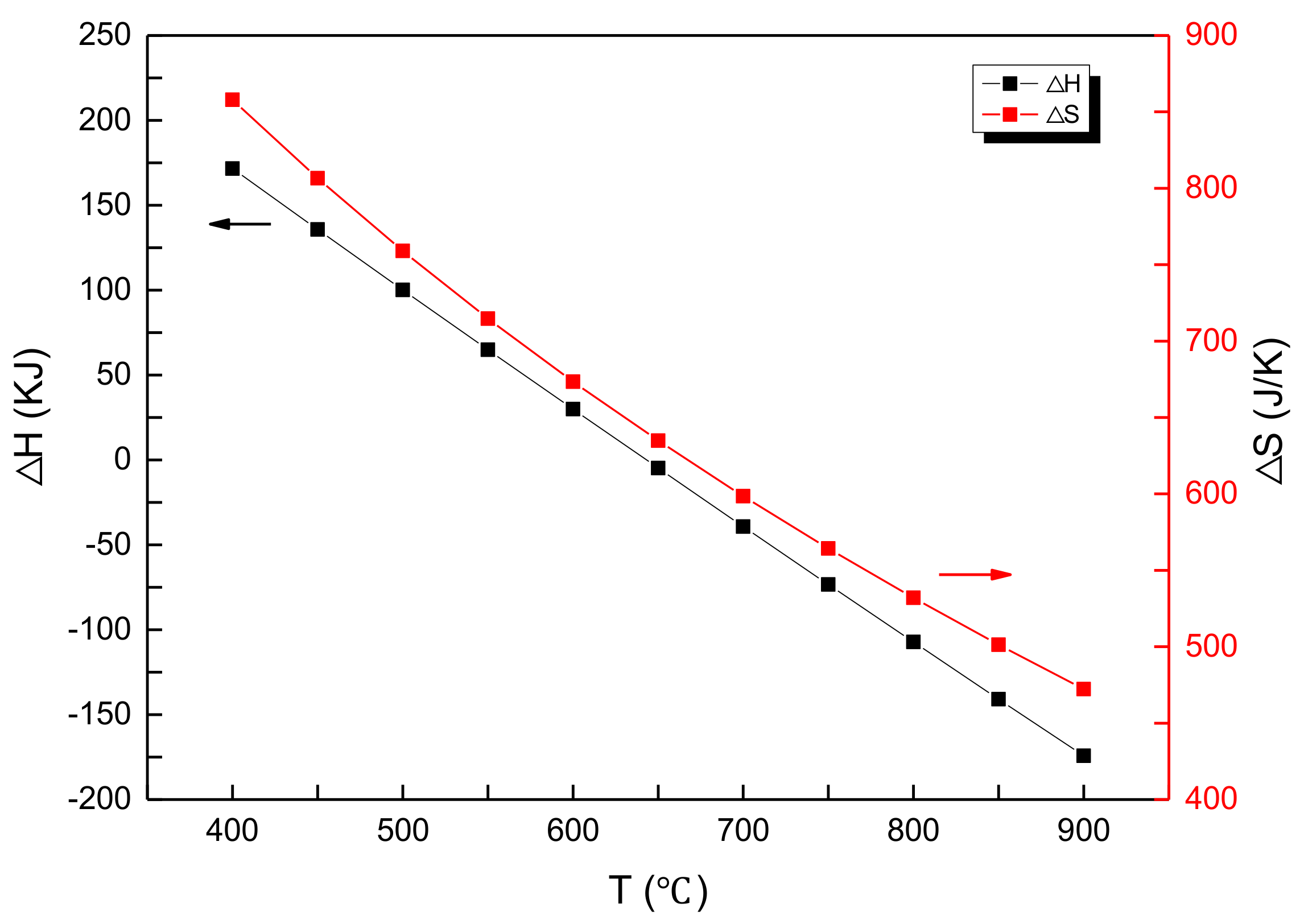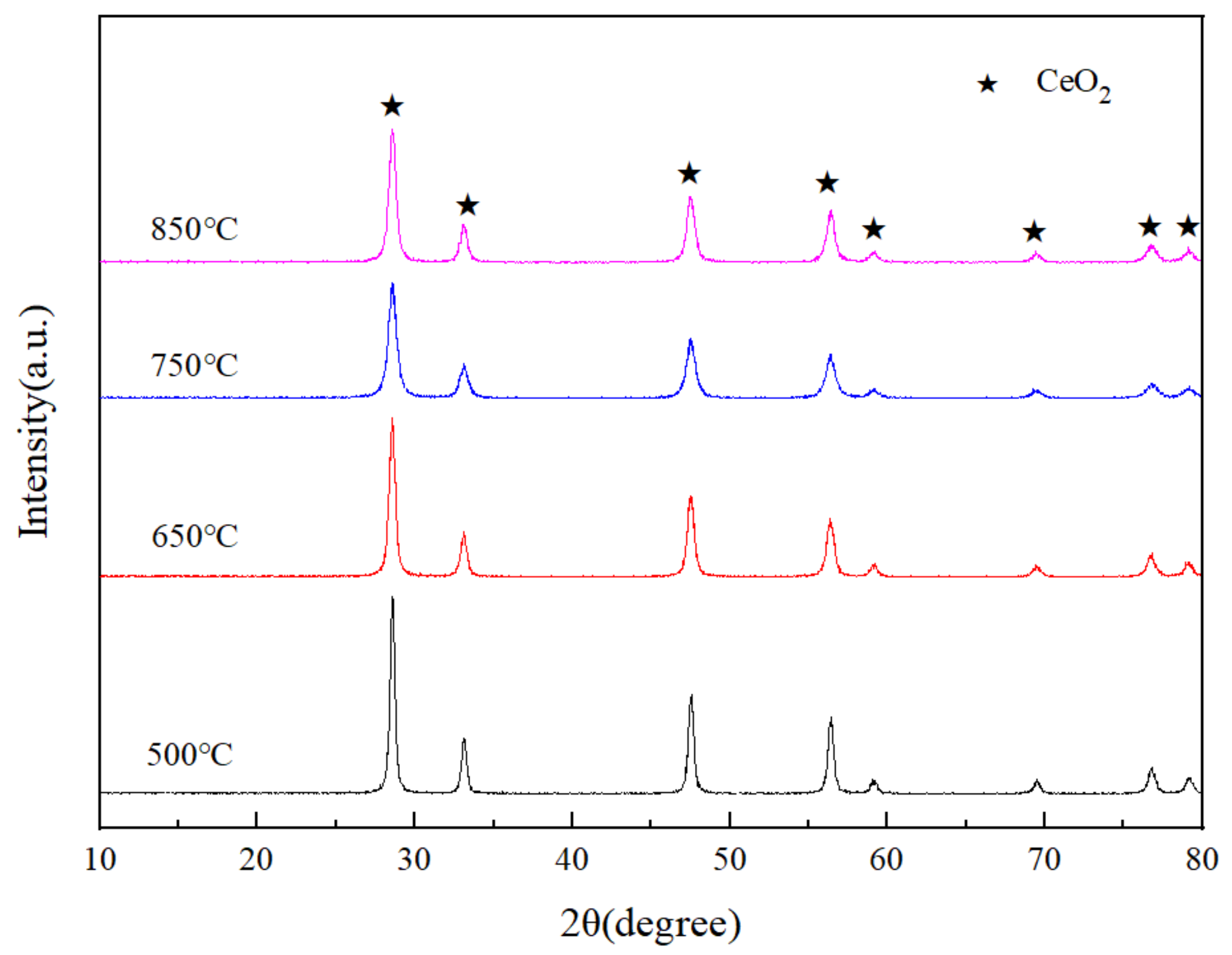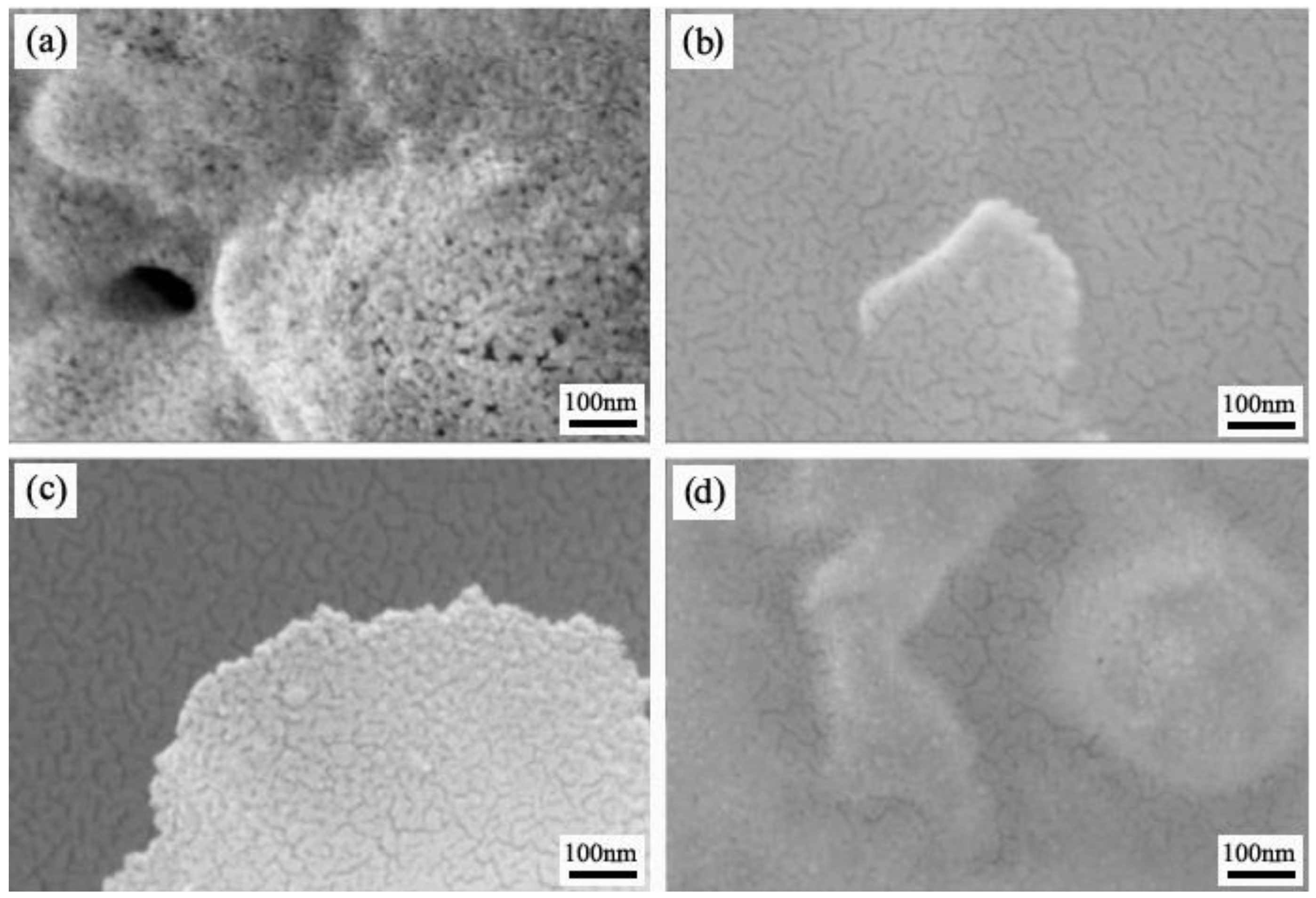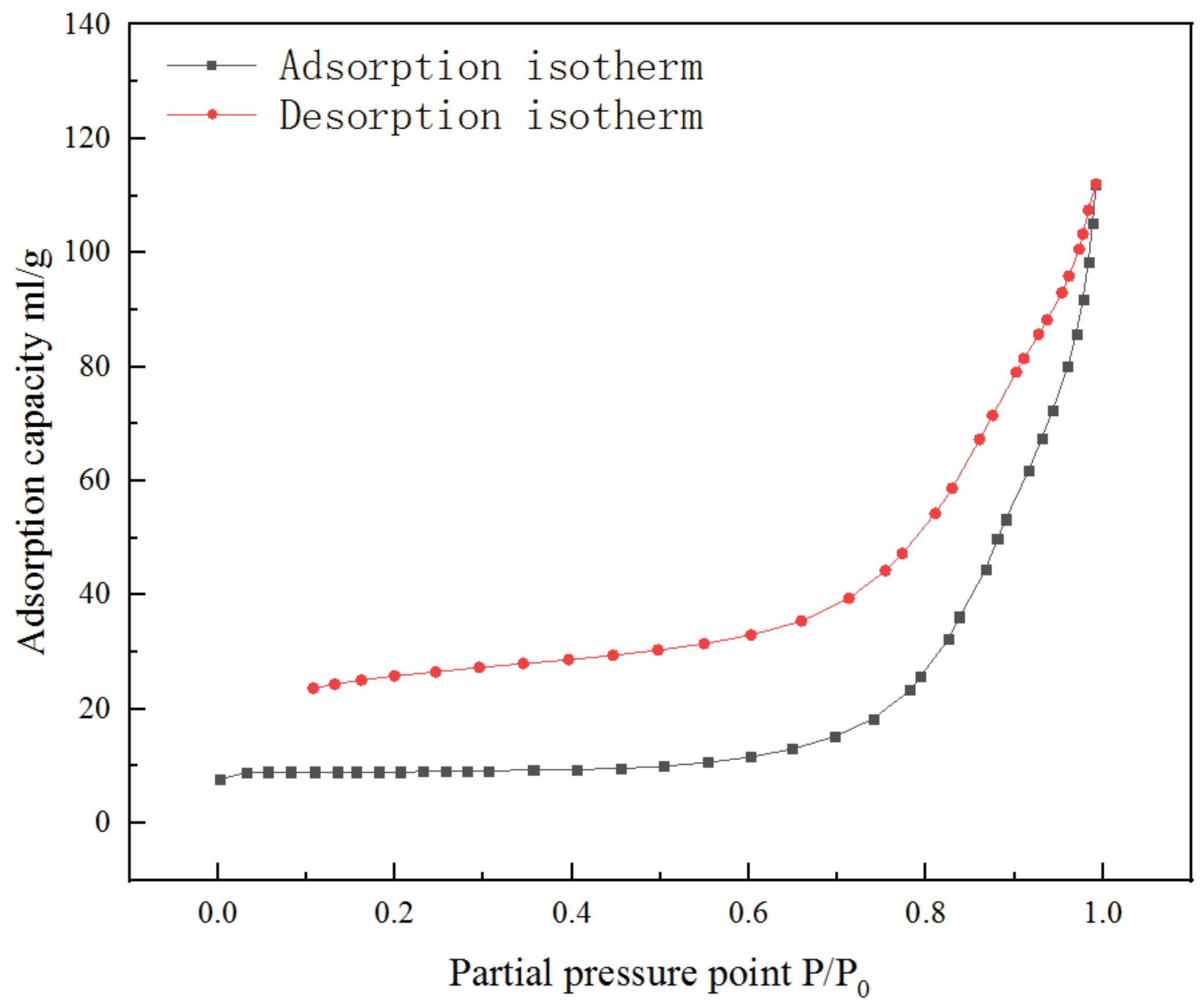Green and Short Preparation of CeO2 Nanoparticles with Large Specific Surface Area by Spray Pyrolysis
Abstract
:1. Introduction
2. Experimental
2.1. Experimental System
2.2. Instrument and Materials
2.3. Experimental Procedures
3. Results and Discussion
3.1. Thermodynamic Analysis
3.2. Characterization by XRD and SEM
3.3. Analysis of Specific Surface Area and Particle Size
3.4. Effects of Citric Acid
4. Conclusions
Author Contributions
Funding
Institutional Review Board Statement
Informed Consent Statement
Data Availability Statement
Acknowledgments
Conflicts of Interest
References
- Yuan, X.; Ge, H.; Liu, X.; Wang, X.; Chen, W.; Dong, W.; Huang, F. Efficient catalyst of defective CeO2-x and few-layer carbon hybrid for oxygen reduction reaction. J. Alloy. Compd. 2016, 688, 613–618. [Google Scholar] [CrossRef]
- Grzybek, G.; Stelmachowski, P.; Indyka, P.; Inger, M.; Wilk, M.; Kotarba, A.; Sojka, Z. Cobalt-zinc spinel dispersed over cordierite monoliths for catalytic N2O abatement from nitric acid plants. Catal. Today 2015, 257, 93–97. [Google Scholar] [CrossRef]
- Thayagaraja, R.; Cheng, S.Y.; Jones, M.I.; Baroutian, S. Catalytic wet oxidation of glucose as model compound of wastewater over copper/rare earth oxides catalysts. J. Water Process. Eng. 2020, 36, 1–12. [Google Scholar] [CrossRef]
- Chen, X.; Yang, H.; Au, C.; Tian, S.; Xiong, Y.; Chang, Y. Efficiency and mechanism of pollutant degradation and bromate inhibition by faceted CeO2 catalyzed ozonation: Experimental and theoretical study. Chem. Eng. J. 2020, 390, 1–13. [Google Scholar] [CrossRef]
- Ippolito, D.; Deleebeeck, L.; Hansen, K.K. Effect of CeO2 Addition on Hybrid Direct Carbon Fuel Cell Performance. J. Electrochem. Soc. 2017, 164, 328–332. [Google Scholar] [CrossRef]
- Montini, T.; Melchionna, M.; Monai, M.; Fornasiero, P. Fundamentals and Catalytic Applications of CeO2-Based Materials. Chem. Rev. 2016, 116, 5987–6041. [Google Scholar] [CrossRef] [PubMed]
- Wu, G.; Zhang, Z.; Chen, X.; Yu, Q.; Ma, X.; Liu, L. Chemosensitization effect of cerium oxide nanosheets by suppressing drug detoxification and efflux. Ecotoxicol. Environ. Saf. 2019, 167, 301–308. [Google Scholar] [CrossRef] [PubMed]
- Shih, C.J.; Chen, Y.J.; Hon, M.H. Synthesis and crystal kinetics of cerium oxide nanocrystallites prepared by co-precipitation process. Mater. Chem. Phys. 2010, 121, 99–102. [Google Scholar] [CrossRef]
- Muduli, S.K.; Wang, S.; Chen, S.; Ng, C.F.; Huan, C.H.A.; Sum, T.C.; Soo, H.S. Mesoporous cerium oxide nanospheres forthe visible-light driven photocatalytic degradation ofdyes. Beilstein J. Nanotechnol. 2014, 5, 517–523. [Google Scholar] [CrossRef] [PubMed] [Green Version]
- Zhou, F.; Zhao, X.; Xu, H.; Yuan, C. CeO2 Spherical Crystallites: Synthesis, Formation Mechanism, Size Control, and Electrochemical Property Study. J. Phys. Chem. C 2007, 111, 1651–1657. [Google Scholar] [CrossRef]
- Mädler, L.; Stark, W.J.; Pratsinis, S.E. Flame-made ceriananoparticles. J. Mater. Res. 2002, 17, 1356–1362. [Google Scholar] [CrossRef] [Green Version]
- Katalenich, J.A.; Kitchen, B.B.; Pierson, B.D. Production of monodisperse cerium oxide microspheres with diameters near 100μm by internal-gelation sol-gel methods. J. Sol-Gel Sci. Technol. 2018, 86, 329–342. [Google Scholar] [CrossRef]
- Wang, Z.; Fei, P.; Xiong, H.; Qin, C.; Zhao, W.; Liu, X. CoFe2O4 nanoplates synthesized by dealloying method as high performance Li-ion battery anodes. Electrochim. Acta 2017, 252, 295–305. [Google Scholar] [CrossRef]
- Zhu, W.; Huang, H.; Zhang, W.; Tao, X.; Gan, Y.; Xia, Y.; Yang, H.; Guo, X. Synthesis of MnO/C composites derived from pollen template for advanced lithium-ion batteries. Electrochim. Acta 2015, 152, 286–293. [Google Scholar] [CrossRef]
- Guo, Q.Z.; Guo, X.H.; Du, K.Q.; Wang, Y.; Guo, Z.G. Effects of nano-porous Ti4O7 conductive additive on the properties of positive electrodes of lead-acid batteries prepared by electrochemical oxidation method. Chin. Labat Man 2018, 55, 211–214. [Google Scholar]
- Lv, C.; Zhang, T.A.; Dou, Z.H.; Zhao, Q.Y. Numerical simulations of irregular CeO2 particle size distributions. JOM 2019, 71, 34–39. [Google Scholar] [CrossRef]
- Wu, W.Y.; Xue, S.F.; Bian, X.; Wang, Z.F. Study on the Preparation Process for CeO2 Superfine Powder. J. Northeast. Univ. (Nat. Sci.) 2015, 36, 800–804. [Google Scholar]
- Lv, C.; Dou, Z.; Zhao, Q. Simulation of Process and Reactor Structure Optimization for CeO2 Preparation from Jet-Flow Pyrolysis. JOM 2019, 71, 1660–1666. [Google Scholar] [CrossRef]
- Lv, C.; Zhang, T.A.; Dou, Z.H.; Zhao, Q.Y. Numerical simulation of preparation of ultrafine cerium oxides using jet-flow pyrolysis. Rare Met. 2019, 38, 1160–1168. [Google Scholar] [CrossRef]
- Guo, L.; Li, L.; Zhang, J. Study new Technol. Prep. nano-cerium dioxide powder. J. Petrochem. Coll 2011, 24, 9–13. [Google Scholar]











| Spray Pyrolysis Temperature (°C) | C6H8O7: CeCl3 (A/C) | |||||
|---|---|---|---|---|---|---|
| 0 | 0.5 | 1 | 1.5 | 2 | 2.5 | |
| 500 | √ | |||||
| 650 | √ | √ | √ | √ | √ | √ |
| 750 | √ | |||||
| 850 | √ | |||||
Publisher’s Note: MDPI stays neutral with regard to jurisdictional claims in published maps and institutional affiliations. |
© 2021 by the authors. Licensee MDPI, Basel, Switzerland. This article is an open access article distributed under the terms and conditions of the Creative Commons Attribution (CC BY) license (https://creativecommons.org/licenses/by/4.0/).
Share and Cite
Wu, Y.; Li, H.; Bian, X.; Wu, W.; Wang, Z.; Liu, Y. Green and Short Preparation of CeO2 Nanoparticles with Large Specific Surface Area by Spray Pyrolysis. Materials 2021, 14, 4963. https://doi.org/10.3390/ma14174963
Wu Y, Li H, Bian X, Wu W, Wang Z, Liu Y. Green and Short Preparation of CeO2 Nanoparticles with Large Specific Surface Area by Spray Pyrolysis. Materials. 2021; 14(17):4963. https://doi.org/10.3390/ma14174963
Chicago/Turabian StyleWu, Yongfu, Hong Li, Xue Bian, Wenyuan Wu, Zhenfeng Wang, and Yubao Liu. 2021. "Green and Short Preparation of CeO2 Nanoparticles with Large Specific Surface Area by Spray Pyrolysis" Materials 14, no. 17: 4963. https://doi.org/10.3390/ma14174963
APA StyleWu, Y., Li, H., Bian, X., Wu, W., Wang, Z., & Liu, Y. (2021). Green and Short Preparation of CeO2 Nanoparticles with Large Specific Surface Area by Spray Pyrolysis. Materials, 14(17), 4963. https://doi.org/10.3390/ma14174963





